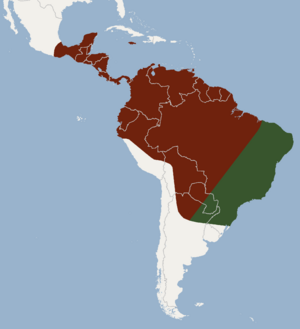Black bonneted bat facts for kids
Quick facts for kids Black bonneted bat |
|
|---|---|
| Conservation status | |
| Scientific classification | |
| Genus: |
Eumops
|
| Species: |
auripendulus
|
 |
|
| Distribution map of the black bonneted bat (based on Best et al., 2002) | |
| Synonyms | |
|
|
The black bonneted bat, also known as Shaw's mastiff bat, (Eumops auripendulus), is a type of bat found in the Americas. These bats are known for their dark fur and unique features. They are active at night and play an important role in their ecosystems.
Contents
What Does the Black Bonneted Bat Look Like?
The black bonneted bat is a medium-sized bat. Adult bats usually weigh between 26 and 38 grams (about 1 ounce). Their head and back are covered in dark brown fur. This fur can be reddish or almost black. Their sides and belly are a lighter, grey color.
These bats have large, round ears. They also have a small, pointed part inside the ear called a tragus. Their wing membranes are dark and have narrow tips. Fur covers the top part of their wings, reaching down to their knees. Their face has very little hair and ends in a blunt snout.
Male black bonneted bats have a special pouch-like organ on their throat. Scientists are not sure what this organ is for. Females have a much smaller version of this organ. This bat looks a lot like the Wagner's bonneted bat. However, Wagner's bat is usually lighter in color. It also has a different shape to its tragus.
Where Do Black Bonneted Bats Live?
The black bonneted bat lives in many parts of the Americas. You can find them in southern Mexico and on the island of Jamaica. They also live across much of Central and South America. Their range goes as far south as northern Argentina. However, they are not found in western Peru, Bolivia, or Chile.
These bats live in many different types of forests. They can be found from low coastal areas to the slopes of the Andes mountains. They live at heights of at least 1,800 meters (about 5,900 feet). For example, in Brazil, they are found in almost every major natural area, called a biome.
Scientists recognize two main groups, or subspecies, of this bat:
- E. auripendulus auripendulus - This group lives in most of the bat's range.
- E. auripendulus major - This group lives in eastern and southern Brazil, eastern Paraguay, and northeastern Argentina.
How Do Black Bonneted Bats Live?
Black bonneted bats are insectivorous, meaning they eat insects. They are also nocturnal, which means they are active at night. During the day, they sleep inside narrow cracks and small spaces. They often crawl into these spots instead of hanging upside down. In larger places, like attics or church bell towers, they might hang together in groups. These groups can have at least fifteen bats.
Female bats can have babies several times a year. Each time, they usually give birth to one young bat.
See also
 In Spanish: Eumops auripendulus para niños
In Spanish: Eumops auripendulus para niños


